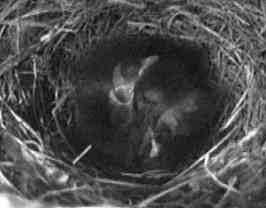A Summary of Weeks 1 and 2
Nest building started on Thursday 15 June and was more or less completed the next day. Saturday saw very little activity at the nest. The first egg was laid at around 8.20am on Sunday morning and each subsequent morning saw another until the fourth egg was laid on Wednesday 21 June. From Friday, the male made a visit early each morning, bringing food for the female.
On Thursday 22 June, after leaving the nest several times before 9am, the female surprised us by laying a fifth egg before 9.30am. Since then she has spent nearly all the time incubating the eggs, only leaving the nest for short periods to feed. The male is staying nearby and always appears when the female feeds. In addition he seems to be taking food away to perhaps feed offspring from a previous brood(?).
Thursday
29 June - A mainly cloudy day saw a continuation of
the female's incubation of the eggs. She does not leave the nest
very often, and then only for short trips for food. Although
I have not been keeping a continuous watch on the nest today
I have noticed the male taking food to the female in the nest
several times .
Saturday 1 July - A cloudy morning with only a few glimpses of sunshine and some light showers. Yesterday was uneventful with the female continuing to incubate her eggs and the male still carrying off mealworms elsewhere.Over a four hour period in the afternoon the female left the nest just four times with an average trip time of eight minutes. That pattern continues today. The picture shows mum in familiar pose at mid-day -
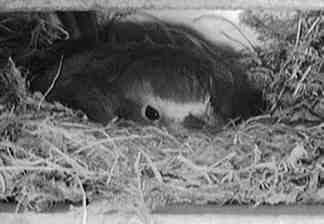
It is now nine days since the last egg was laid. An incubation period of 12 - 15 days means that they could hatch from Tuesday onwards next week so this weekend I must get my video tapes organised and recorders cleaned!
During the day, from 8am until 10pm I have kept a record of the female's trips away from the nest. In those 14 hours she left the nest 10 times. These excursions lasted between 6 and 25 minutes, with the total time away being 2 hours. The last trip out was at 8.12pm for 11 minutes. During these fourteen hours she remained remarkably still in the nest. Only a few times did she seem to check on the eggs and they do not seem to have been moved or turned at all. Quite frequently she spent short times with both eyes closed and around 11am she actually spent the best part of ten minutes with her head buried under her wing. The male only came to the nest once with food, at 9.11pm.
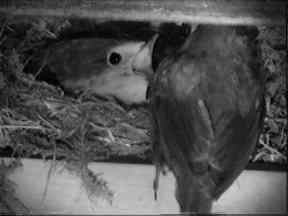
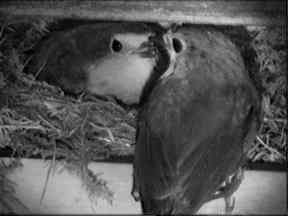
Only once did I see the two birds together in the garden today and then it was competition rather than co-operation over mealworms with the male gathering a beakful to take away again.
I have noticed that a number of time today, before collecting mealworms the male has coughed up black pellets which I have collected. They seem to consist mainly of beetle wing cases, one or two of which are quite iridescent, and other exoskeleton remains. I may take a closer look tomorrow.
Monday 3 July - A day of broken cloud and sunshine (max 21-22C) with some rain at lunchtime.
The female continued to incubate the eggs for most of the day. The male was about quite a lot but I only saw him go to the nest once during the day. That visit took place while I was trying to get a photograph of the female in the nest so with a bit of luck I will have captured the moment on film. I must wait to see if he was in focus! When the female left the nest I took the oportunity to photograph the clutch of eggs before hatching starts in the next day or two.
I have taken a close look at the contents of the pellets I mentioned on Saturday. Mostly they consisted of fragments but I was able to see a small black, highly iridescent beetle prothorax, slightly trapezoid in shape and covered in tiny 'dimples', especially around the edges. It measured about 1mm x 0.6mm. There were also a small selection of beetle wing covers (elytra) from at least three different individuals. One appeared to match the prothorax in colour and patterning, it measured about 1.5mm x 0.5mm. The other two were brown in colour and larger.
The pellets also contained the 'skins' of a couple of mealworms (I think) and the almost complete exoskeleton of an ant, complete with legs and antennae.
The weekend has seen the end of any remaining dependence that the blackbird fledglings had on their parents. Today there have only been occasional, independent visits by each parent and at least one juvenile blackbird.
Tuesday 4 July - Have a good Independence Day America!
On an overcast morning the eggs were still intact at nearly 9am when mum left to feed. She is now back on the eggs. Dad paid a visit at 10am bringing a caterpillar for her.
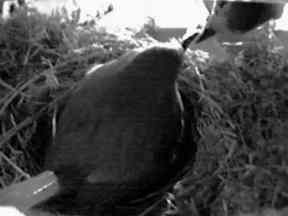
The Eggs are Hatching....
This afternoon has brought the 'breakthrough'. At 1.24pm, just after the female had left the nest, a split appeared in one egg (pic1). Over the next couple of minutes the split had increased by just a small amount before mum returned. She pecked at the shell a few times, breaking some bits off and then she picked up the shell and unceremoniously tipped the chick out onto the other eggs (pics 2&3). After a short pause she removed both halves of the shell from the nest.
While she was away the chick struggled to move about, obviously hungry (pic 4) and gave us out first look at its 'punk' look and at the pattern of dark areas on the back of its head and its wings (pic 5).
|
|
|
|
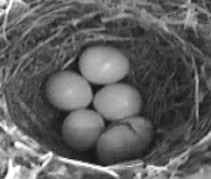
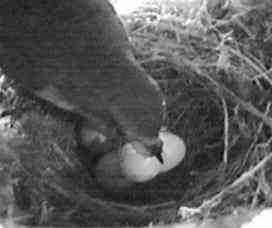
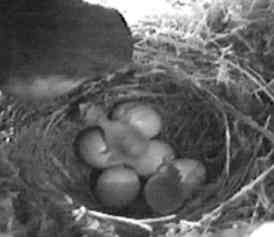
|
|
|
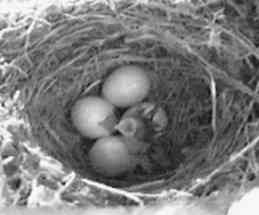
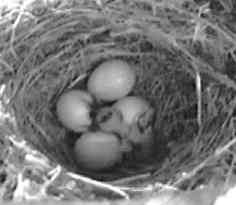
By3.30pm three eggs had hatched. Here is a picture of mum removing part of the third shell. You can see one hungry mouth below her that has already been fed a couple of times.
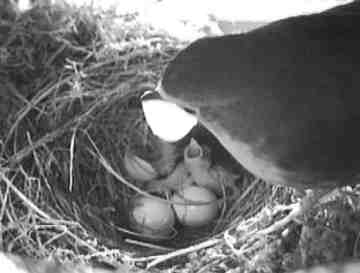
Soon after 6pm the male arrived and for the first time both parents were offering food to the chicks.
At 7pm there is still one egg in the nest. One of the parents arrived a couple of minutes ago with a worm which was much too big for any of the chicks to cope with. The worm was dropped and there now seems to be a problem as it appears to be stuck to a couple of the chicks and mum(?) cannot pull it off!
Wednesday 5 July - A cool and cloudy morning, brightening up later.
The female left the nest for the first time at 4.35am, when it was very wet and still dark. She was back a few minutes later with the first feed of the day. She brought back three more feeds in the next ten minutes before settling on the nest again . The fifth egg was still intact at this time. the process was repeated fifty minutes later. Another hour passed before she left again. While sitting in the nest she occasionally reached up to the front edge of the box roof to drink a water droplet that formed there. The male appeared for the first time just before 7am.
As for the fifth egg... it hatched shortly before 10am.
From then on through the rest of the day feeding has been shared by both parents, with the chicks receiving a varied diet in addition to the mealworms on offer. I was surprised to see the ease with which mealworms were accepted by the chicks, without the 'processing' that was carried out by the blue tit parents.
This image, as the male brought a mealworm, was our first chance to confirm that the five chicks are alive, one just has flopped face down across the middle of the group.
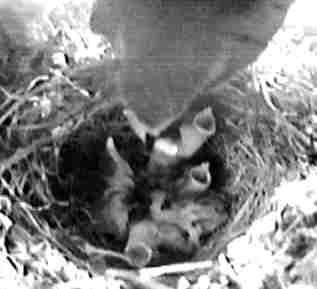
The sparrowhawk made a successful kill in the garden today, a sparrow (I had a quick check to confirm no red feathers!), and spent a short time, perched on a wooden framework, plucking it so that the feathers scattered over the grass!
The parent robins continued feeding the chicks until nearly 10pm and as I write this at 10.50 pm the female has left the nest again, leaving the chicks huddled together in what looks like a dark fuzzy halo created by their downy coats.
